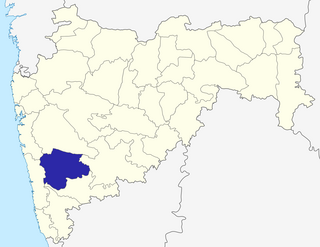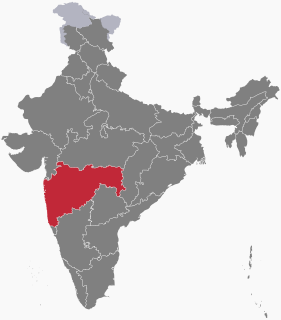The Bhonsle are a prominent group within the Maratha clan system. Traditionally a warrior clan, some members served as rulers of several states in India, the most prominent being Shivaji, the founder of the Maratha Empire which opposed the rule of Mughal Empire in Indian subcontinent. His successors ruled as chhatrapatis (maharajas) from their capital at Satara, although de facto rule of the empire passed to the Peshwas, the Maratha hereditary chief ministers, during the reign of Shahu I. In addition to the Bhonsle chhatrapatis of Satara, rulers of the Bhonsle clan established themselves as junior branch of chhatrapatis at Kolhapur, and as maharajas of Nagpur in modern-day Maharashtra in the 18th century.

Kunbi is a generic term applied to castes of traditionally non-elite farmers in Western India. These include the Dhonoje, Ghatole, Hindre, Jadav, Jhare, Khaire, Lewa, Lonare and Tirole communities of Vidharbha. The communities are largely found in the state of Maharashtra but also exist in the states of Madhya Pradesh, Gujarat, Karnataka, Kerala and Goa. Kunbis are included among the Other Backward Classes (OBC) in Maharashtra.
Nayak or Naik is a historic title conferred to Sardars, Governors of the feudatories in medieval times.
The Marathi people or Maharashtrians are an ethnolinguistic group who speak Marathi, an Indo-Aryan language as their native language. They inhabit the state of Maharashtra as well as districts bordering the state, such as Belgaum and Karwar of Karnataka and the state of Goa in western India. Their language, Marathi, is part of the of Indo-Aryan language family. It is to be noted that the term 'Maratha' by historians, is at times used to refer to all Marathi speaking people, irrespective of caste and at times to a Maharashtrian caste called Maratha. The Marathi community came into political prominence in the 17th century when Maratha warriors, under Chhatrapati Shivaji Maharaj, established the Maratha Empire, which is credited to a large extent for ending the Mughal rule. All Marathi people are at times pejoratively called Ghati by immigrants to Maharashtra, and specifically to Mumbai, from other areas of India.

Mantha is a town and a tehsil in Partur subdivision of Jalna district in the state of Maharashtra, India.

Wadwani or Wadvani is a tehsil in Majalgaon subdivision of Beed district in the Indian state of Maharashtra.

Tadawale Sammat Wagholi is a small town and gram panchayat in Koregaon taluka, Satara district, in the Indian province of Maharashtra.
Shiledar was a term used for a soldier's position, particularly in India's Maratha Empire (1630–1818), and especially during the reign of king Chhatrapati Shivaji maharaj. The word shiledar means "a soldier who possesses his own sword and horse for taking active part in combat/war".

There is a water fall named BHAIR KUNDA in Jaoli. There is a big lake situated between hills in jaoli.

The Koli people are an ethnic Indian group native to Rajasthan, Himachal Pradesh, Gujarat, Maharashtra, Uttar Pradesh, Haryana states.
Gaekwad is a surname native to Indian state of Maharashtra. The surname is found among Maratha Kolis caste and Scheduled caste people. It is also a common surname among Bharadis, Dhor Kakkayya, and Mahar communities of Maharashtra.

Bhoite Saranjam was one of the political saranjams of British India under the Bombay Presidency. Its capital was Jalgaon City. It was a Maratha jagir of the Bhoite clan.

Wagholi is a settlement in Satara District of Maharashtra State, India. This town is situated in the North Koregaon region. Wagholi plays an important role in the political, economic, social, cultural, and educational lives of people in the Koregaon, Taluka, and Satara Districts.
Shimpi is a caste from Maharashtra, India which literally means business in clothing, tailoring.Meru Shimpi or mera or chippolu or just Shimpi is a caste from Maharashtra, Telangana and Andhra Pradesh India, which is categorized as Other Backward Class. They are present all over Maharashtra and teluguTelugu states. Meru kshatriya Shimpi literally means business in tailoring. This caste has its source from Andhra Pradesh and Telangana, and is divided between Maharashtra and Telugu states.

Garavadi (Ramnagar) is a census village in the Satara district, in the India state of Maharashtra. The village is located in Khatav Tehsil of Satara district in Maharashtra, India. It is situated 32 km away from the sub-district headquarter Vaduj, and 54 km away from the district headquarter Satara. As of 2009 statistics, Garavadi village is also a gram panchayat. Garavadi is surrounded by a big mountain. There is the large temple of Ram at the centre of the village. Agriculture is the main land use in this village, with more than 75% of the total area being used for agricultural activities. It is situated on the east side of Diskal Village.
Vithal Sakharam Parasnis (17xx-18xx) was popularly known as 'Aba' hence he is usually referred to as Aba Parasnis by sources. He was a Sanskrit, Vedic and Persian scholar of the early 19th century Maharashtra. He was a native of the Satara district of Maharashtra.








